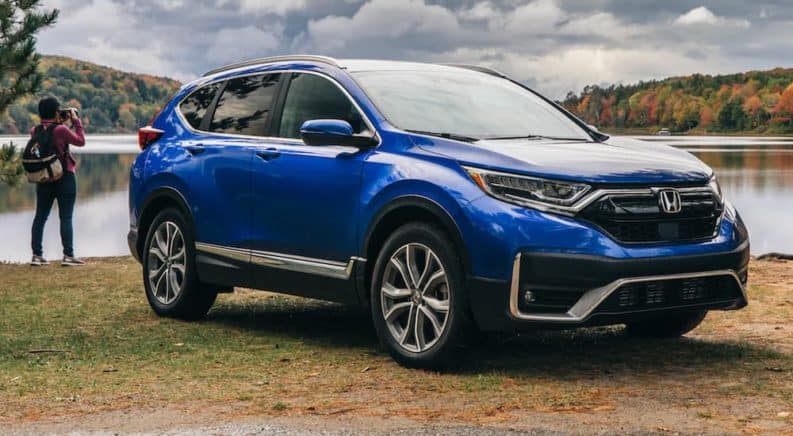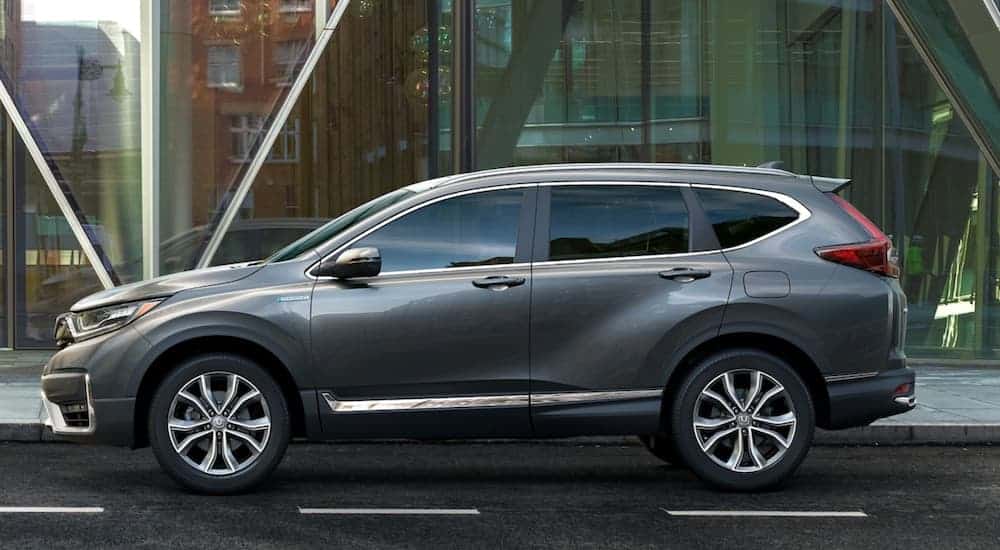If you’ve driven on a road in America even once, chances are you passed a CR-V (or a CR-V passed you). This ubiquitous little crossover has managed to capture the hearts of practical buyers since its debut in 1997, back when shoulder pads still made sense. If you’re practicing responsible adulting, head to a Honda CR-V dealer, pick your color, and join a growing tribe of really good decision-makers.
All kidding aside, we marvel at Honda’s consistency with the CR-V. Most long-run nameplates have at least one or two off years; not so with the CR-V. While you won’t win any off-the-line street races, you’ll probably pass more auto repair shops than any other competing SUV owner. That’s cool, too, right?
The current 2021 CR-V is a value-priced option that sits at the mid-range of its category and try as we might, we can’t spec one out that costs more than $40,000. That may seem like a lot of money, but what if your CR-V carries you a million miles?
In October 2018, a guy by the name of Joel posted a YouTube video of his 2000 CR-V’s odometer hitting 980,000 as he cruised through Tulsa, Oklahoma. By our calculations, that car has cost him less than .02/mile. Not bad. Not bad at all. Welcome to the High Mile Club, Joel.
It got us wondering, is this newest CR-V stacking up to its predecessors? We take a deep dive into Honda’s current technology and how its current lineup of CR-Vs contributes to its reputation for industry-leading reliability.
New for 2021: Hybrid Power
Honda is moving forward with electric power technology, but in the interim, the hybrid option is part of its CR-V trim lineup for 2021. This dual-motor powertrain includes a 2.0 liter, DOHC I-VTEC engine and an electric motor to deliver 40 MPG of fuel economy during city driving. That efficiency doesn’t mean performance suffers; the CR-V Hybrid pumps out a respectable 212 horsepower, giving it plenty of acceleration.
The onboard Driver Information Interface lets drivers know where the power is coming from and displays information on battery charge levels and whether the battery is actively charging. Three drive modes––Sport, Econ, and EV––are available with a simple push-button setting. Econ focuses on fuel economy, while Sport mode delivers a sportier ride. EV mode draws power exclusively from the electric motor.
Since the CR-V Hybrid is standard with all-wheel drive, it’s ready for more challenging driving conditions. It’s a Real Time all-wheel drive system relies on a series of sensors to detect road conditions and adapt torque and traction for optimal ride handling. The CR-V was extensively tested in extreme conditions, so it’s a good bet it will take care of business in the carpool lane.
The Honda Sensing Suite
Thanks to exhaustive research and testing, Honda has released one of the industry’s most comprehensive suite of driver-assist safety systems, The Honda Sensing Suite. Acting as an invisible copilot, The Honda Sensing Suite uses sensors and cameras to monitor driving conditions and alert the driver when it senses potential hazards or imminent collisions, providing mitigation in some cases.
Starting with Collision Mitigation Braking System (CMBS), which will automatically apply the brake when it determines the vehicle is headed for an unavoidable frontal collision, the Honda Sensing Suite is designed to keep occupants safe in unfortunate scenarios, but more than that, the system exists to help drivers avoid unfortunate scenarios in the first place.
Road Departure Mitigation System (RDMS), another feature of the Honda Sensing Suite, works by determining whether the vehicle has drifted into another lane when the turn signal isn’t engaged. It assesses the movement as unintentional and quickly alerts the driver. It can even provide steering assistance to nudge the vehicle back to its intended lane.
One of the most sought-after driver-assist systems is Adaptive Cruise Control (ACC). Often an option outside of other manufacturers’ standard driver-assist packages, Honda includes it. The system is a safety feature and a convenience feature because once the driver sets the cruise control, ACC takes over, automatically adjusting the speed to keep a consistent, safe distance from the vehicle ahead. That’s not all it does, though. The Low-Speed Follow feature actually brings the CR-V to a full stop when the vehicle ahead does (like in stop-and-go traffic). Simply tap the gas pedal, and the car resumes its ACC function.
Lane Keeping Assist works alongside RDMS to keep the vehicle in its intended lane of traffic. This is especially helpful during long highway drives because the system continuously sends nudges to the driver via steering cues to help keep the car centered in its lane. It’s a great feature to keep the driver engaged on a boring stretch of highway when it would be easy to lose focus.
Current Technology
The nice thing about this current CR-V is its scalable technology. What we mean is, it’s not likely to become obsolete quickly because the CR-V’s onboard tech is powered by Honda’s powerful operating system, HondaLink, which receives over-the-air-updates, keeping it current. With the speed of technological advancements, it’s nice to know it’ll be a few years before the tech ages out.
Speaking of HondaLink, the system does more than just act as a gateway for interfacing with drivers – it also exists as an app on your smartphone. It’s able to receive vehicle-related notifications, as well as provide drivers an easy way to schedule service appointments and view vehicle diagnostic information.
While you’re driving a million miles, you’ll stay very happily entertained with the 7-inch infotainment touchscreen centrally-mounted on the CR-V’s well-laid-out dash. The touchscreen integrates your smartphone capabilities via Apple CarPlay or Android Auto, so access to podcasts or music streaming apps is seamless. Broadcasting them via the standard 9-speaker, 300-watt premium audio system with subwoofer is a little like having a mini-concert right in the car.
A standard multi-angle rearview camera rounds out the extensive standard tech features on the newest CR-V. The three views – normal, top-down, and wide – give you expansive views behind the vehicle to aid with backing out of parking spaces or driveways safely. Some CR-V trims expand that visibility to exterior features, with standard LED headlights that not only look futuristic but increase visibility to other drivers and even pedestrians.
Joel likely made it to a million miles in his CR-V, and we’d wager the newer models are even more reliable, thanks to Honda’s relentless pursuit of quality. Honda is a company that had an eye on globalization from day one, which meant understanding the values and priorities of all customers. Its strategy of setting up autonomous engineering, design, manufacturing functions at each of its facilities means that Honda’s local teams can get to know the specific needs of buyers in their corner of the world.
Time to Find Your CR-V
From the early days, Honda understood that Americans value quality and reliability. They want great looking cars, yes, but more importantly, they want to count on their cars to keep them safe and get them where they need to go reliably. Honda uses human labor more than most other manufacturers and employs product-focused engineers in executive roles. Its assembly lines are flexible and can switch between models easily. They can also address issues more quickly.
It’s all of these facets that combine to deliver some of the highest quality cars, trucks, vans, and SUVs on the road, even today. Maybe even more so today. One thing you can count on when you buy a Honda: long-lasting reliability.





